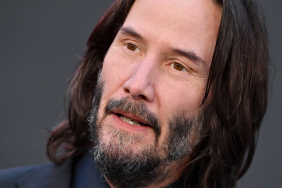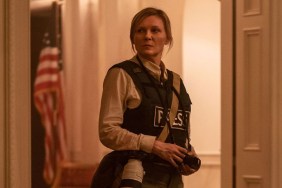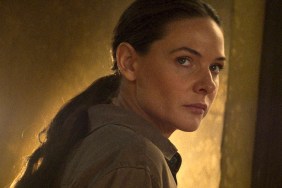Interviewing the director and star of Hungary’s Oscar hopeful Son of Saul
When first-time Hungarian filmmaker Laszlo Nemes’ directorial debut Son of Saul premiered at the Cannes Film Festival, it seemed like just another Holocaust drama that was picked up by Sony Pictures Classics in hopes it would be that country’s Oscar selection. It was pretty obvious by the time Cannes was over that not only would Nemes’ film be Hungary’s pick but that it has a good chance of winning the Oscar in the foreign language category.
The film stars Géza (pronounced with a hard “G” like “geezer”) Röhrig, a poet who only played a small role in a Hungarian mini-series in the late ‘80s and hadn’t been on-screen since, as Saul Ausländer, a Hungarian Jew at the Auschwitz-Birkenau prison camp working as a Sonderkommando, Jewish prisoners forced to help the Nazis with their plans for extermination. When Saul finds the body of a barely-living young boy in one of the gas chambers, he becomes obsessed with getting the boy a proper burial and blessing by a rabbi rather than being cremated.
It’s an amazing first film, first due to the way it’s filmed with the camera following closely behind Saul with many long takes as he walks through the concentration camp encountering all sorts of conflicts and allies, the production design creating an amazing space despite the film’s fairly low budget. It’s a very distinctive movie that’s more exciting and suspenseful than most Holocaust films based on real stories. (Saul is a fictional character and his story, while also fictional, is fairly representative of the internal conflicts of the Sonderkommando as the helped Nazis kill their fellow Jews.)
A few months back, ComingSoon.net had a chance to sit down with Nemes and Rohrig (joining us later) while they were in town presenting the film as a special sidebar of the New York Film Festival. (It turns out that Rohrig has lived in New York for over a decade.)

László Nemes: My interest originally started when I read for the first time the so-called Scrolls of Auschwitz, the writings of the “Sonderkommando” members, these prisoners who as you know where isolated from the rest of the camp and forced to be in the crematorium and erase the traces of the extermination. These people actually took notes in captivity about their everyday lives, a lot of them did, and wrote down what was supposed to be a testimony, not only of their existence, but more importantly of the extermination. They thought that nobody would know after all the Jews are destroyed what happened, so they wanted to take notes and they did. These notes were put into the ground and some of them were found after the war. So that was why I wanted to make the film within the Sonderkommando, but the memory of the Holocaust, I live with it since my childhood. It was something that was communicated to me by my mother mainly, and I wanted to make a film on that.
CS: It’s also a very enclosed system, because it could theoretically take place over two hours in real time. It’s not the story of someone living in a concentration camp for weeks or months…
Nemes: Yes, usually that’s the pattern.
CS: And then we see them escape or see how it affects them. But in this case, we see someone already at a camp and we don’t know much about him beforehand.
Nemes: Yes, exactly, because it also communicates something of the experience of the camp, how little you would know while you were in the middle of it, how little information would come to you and how little see of this. There’s something that I wanted to make a film very limited in space and time, because as a human being, you were limited in space and time. In Auschwitz, the life expectancy upon arrival was like ten days, and sometimes, I think, for these people, their lives before must have seemed unreal. This present must have been incredibly intense and something hard to imagine, so I wanted to communicate something of an experience that’s otherwise hard to communicate. Cinema can help I think communicating this kind of visceral experience.
CS: But I think many filmmakers have tried to create this big panoramic epic and you very deliberately kept it in enclosed shots just on him, and that was something you knew you wanted to do from the very beginning?
Nemes: Yeah, of course, very much so. What is the point of view of the panoramic epic film? What is this point of view? What is Godlike all-encompassing point of view in this kind of situation? Who sees that? What kind of human being can see that if it’s not the guard or the bird.

CS: But even the opening shot where I’m sure everyone seeing this movie is going to say “Hey, it’s not in focus” because you made a conscious decision to do that, too.
Nemes: Yeah, it had to be restrained from the beginning.
(At this point, we were joined by Nemes’ lead actor Geza. Rohrig.)
CS: What was your own interest and experience with the film? Did Laszlo come to you with a script and what was your connection to the material beforehand?
Géza Röhrig: I was born and growing up in the so-called Killing Zone. Budapest and Hungary generally, it’s where one of the saddest chapters happened. This was the last country occupied by the Nazis, and in the matter of eight weeks, they basically deported and murdered half a million Hungarian-speaking Jews, so it’s very much part of our history, and also my grandfather was part of it. He lost his parents, his younger brother, his older sister, and then I went to Poland. I studied in Poland and early on, I was 19-years old, and I first visited the camp, Auschwitz. It was still under the Soviet’s care, it wasn’t such a tourist attraction. It is a very different place now, and so I spent some substantial time there. My first poem book is all about Auschwitz, so I did not meet with this subject matter reading the script, but I was very relieved reading the script, because at first, I was suspicious. There’s no need for just another one of this genre, and I was very happy to see that and it made me able to believe in this movie from the get-go. There’s a lot of pitfalls and things to be avoided when someone makes a Holocaust movie: being sentimental or voyeurish, showing too much. Not watering it down, not to bring too many compromises, not to be too entertaining, but not to deviate from historical reality if it’s possible. This was the first film to my knowledge that was fiction on the one hand, not documentary, but really in a very disciplined way, it stuck to and brought to life something very experiential. Just one day of one person without trying to novelize it. We all know the facts but the question is “Can you take me there?” and this movie does just that.
CS: Was it obvious from the screenplay what Laszlo had planned in terms of having the camera on you the whole time?
Rohrig: It’s hard for me right now to remember. Some of those things obviously came to me through our conversations as well. I’m not a professional script reader, but we spent a lot of time, besides rehearsing and auditioning. We drank a large amount of coffee at night talking through the cinematography and I was also on the same page with all this. By the time the shooting started, I knew basically what type of movie we were making.
CS: I was curious about the logistics of making a film like this because when Hollywood makes a movie like this, Steven Spielberg has $100 million to make it. You obviously didn’t have that.
Nemes: I had one percent of that.
CS: So how do you get the money together to make a movie of this scale?
Nemes: You have to smart when using the means at your disposal, so I didn’t want to make the film this way because I didn’t have money, but I knew that I couldn’t make this film because the way I intended to do it allowed us to use the means at our disposal in a very smart way, and an effective way. But we still had hundreds of extras for days and days. The immersive quality of the film allows us to have very little in a sense. When you make big panoramic establishing shots then you have to have much more money I guess.

CS: But you still have to have set decorators create the environment. I don’t know how much you actually built in terms of sets…
Nemes: We did build parts of the sets, but we had to understand at what point we would be able to make compromise. Having little money just pushes you into more creative directions I guess, but we only had 28 days to shoot so it was very low.
CS: I’m also curious how you’re able to convince extras to be in a film like this, because what are you going to tell them? “Take off your clothes and we’re going to drag you around on the floor…”
Nemes: I don’t want to get into the answer of that. For me, what’s in the movie is still a little sacred so I don’t want to reveal too much.
Rohrig: But we’ve very thankful and I’m sure some of the people of the team, too—I’m still in touch with some of them.
CS: Did a lot of the people involved have a connection and want to be involved in telling this story?
Nemes: Everybody understood the importance of making this film, so everybody understood the sacrifices that had to be made.
CS: There’s a sense of urgency to everything that happens in the film, not just because the Sonderkommandos might be killed at any time, but also the Nazis realize the war is almost over and they’ll be discovered. Can you talk about setting the story during that particularly point during the war?
Nemes: When I wanted to make this film about the Sonderkommandos and about this man in the Sonderkommandos, I couldn’t separate it from the rebellion. For some reason, the rebellion of the main character in a sense is more intense against the backdrop of the rebellion of the Sonderkommando. These people were trying to resist for different reasons, but also because they know they will be liquidated. We have this man who is trying to resist for some very personal metaphysical reason, if you will.
CS: Also the logistics as an actor knowing the camera is always behind you, did that involve a lot of rehearsal to be able to accomplish that?
Rohrig: It’s a lot of rehearsal. It was the cinematic equivalent to dancing because it’s really dancing. I wasn’t doing this by myself. It was also very hard for him—the camera is weighty, it’s a heavy instrument and often he had to walk backwards with it. If you noticed, there’s about 80 cuts in the movie. That’s very few. Usually there are 200-300 but the scenes are long, so sometimes we ended up 50 or 100 feet where the camera started, to go left, right, up, down, so yeah, there was a lot of rehearsing, even without the costumes, just to make sure that the movements are alright.

CS: How do you keep the mood on set up and keep everyone motivated, because it’s so difficult in terms of the tone and setting?
Nemes: I think the fact that we have these shots of 2, 3 or 4 minutes, this immersive shots, actually created a sense of concentration and also a feeling that we’re there and not on a movie set. A lot of lights were integrated into the set, so they were more like a practical light, and this contributes also to the fact that the cast and crew had the feeling of being in a war zone or a concentration camp and it just made everything more believable, and people believed in it. I think it was terrifying to be on the set in a way.
Rohrig: Right, but it was just really praises Laszlo, especially for his first feature. Some of the people he had never worked with before because it was a larger feature movie and he still selected them well, so that they really were motivated, not just faking it.
CS: It looks like that. The movie is amazing and it takes more than two people, it’s everyone. Where do you go from here?
Rohrig: To the restaurant… I’m joking.
CS: But after that? Obviously this movie has gotten a lot of attention so do you feel you have more stories you need to tell on your own before looking at other scripts?
Nemes: Yeah, that’s what my agents ask me. (chuckles) I’m open. It’s just that for the moment I’d like to keep control and own the material I develop, so I have a next movie in Hungary lined-up. It’s a story from before World War I. It’s the story of a young woman, a thriller, so for the moment I’m doing my own projects.
Rohrig: So I have to change my gender for the role.
CS: The Hungarian film industry has exploded with a lot of big films shooting there including “The Martian.” Is it easier or harder as an independent filmmaker to get movies made there?
Nemes: Well, it’s crews. Now it’s hard to get a decent crew in Hungary because the crews are taken by the machines.
Rohrig: They pay well.
Nemes: And also because they shoot a lot. So it’s harder to get crews, but apart from that, I couldn’t afford the big studios (soundstages) anyway and we were shooting more on real locations in studios.
CS: But you said you built some stuff?
Nemes: Yes, but on pre-existing buildings.
CS: Are you generally acting regularly there?
Rohrig: I got some offers. I’m still waiting for the one that I can fully fall in love, but I am open, definitely.
CS: Do you have regular work in Hungary?
Rohrig: No, I’ve been living in the U.S. for 15 years. I’m living in Riversale, so I’m a local, so to speak. By profession, I’m a Judaic studies teacher, but who knows what the future brings? Ask me in a year or two.
Son of Saul opens in New York and Los Angeles on Friday, December 18 and will probably expand further throughout the first few months of 2016.









